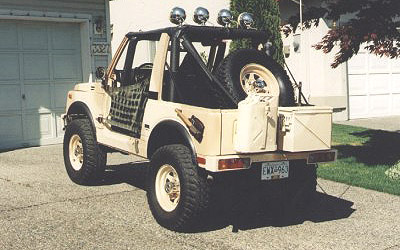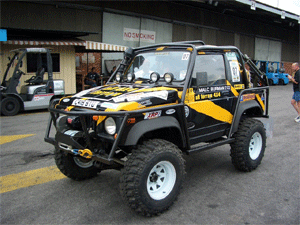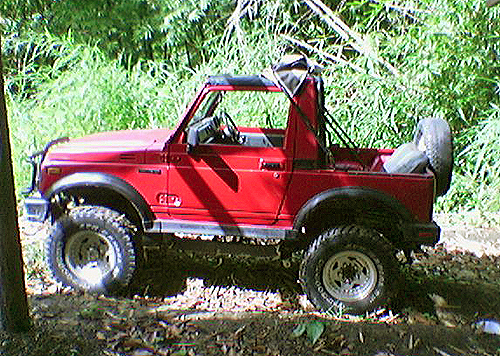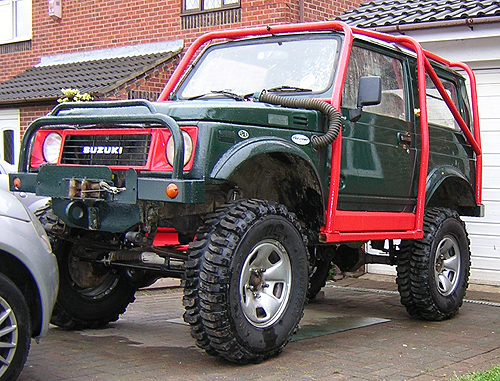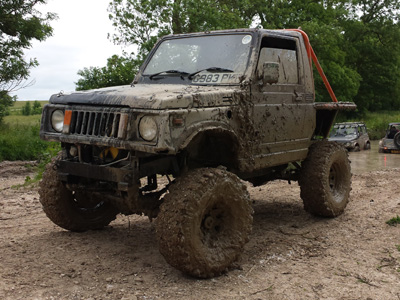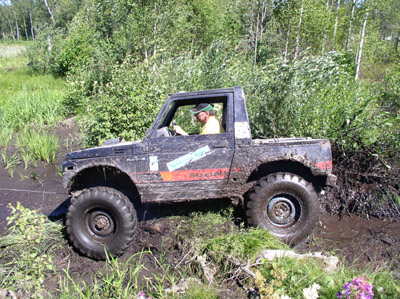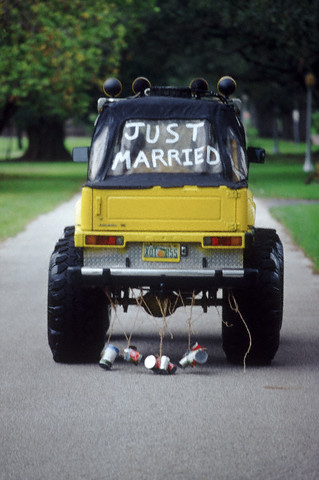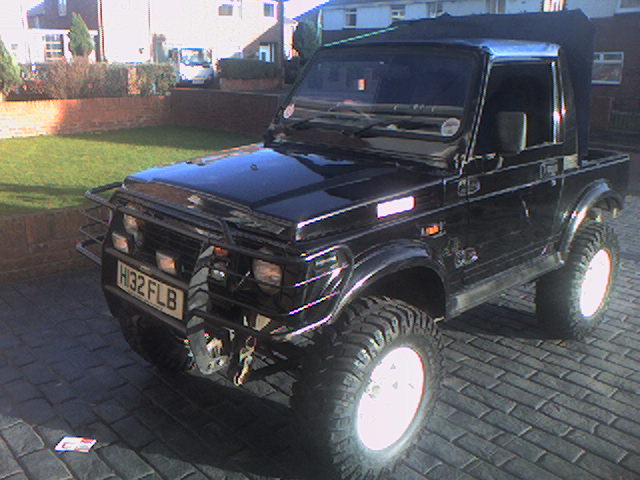Buying a Suzuki SJ
First things first you need to decide which model of Suzuki you want, I won’t go into details of all the model codes (VBJA, QJA, Sport etc.) just the three basic models.
The following is a rough guide to the models and changes, the years are approx.. dates, there are variations between when the changes were made in other countries and many have been privately imported. Plus the fact many SJs have been modified from their original spec over the years and upgraded.
SJ410


The SJ410 is the earliest of the three Suzuki SJs that were introduced into the UK around 1982/83 and came with a 970cc engine with an iron block and aluminium head with 45bhp@5500rpm and54lbs/ft@3000rpm, a 4 speed manual gearbox, 4.11:1 diff ratios and drum brakes front and rear, a transfer box drum parking brake and what is known as the ‘skinny prop shafts’. The interior had a metal dash board and the same steering wheel as the LJ80.

Around 1984 the front brakes were uprated to discs and they started fitting the newer style transfer box with a 4wd light switch, which is essentially the same transfer box that was used for the rest of SJ series but has lower gearing fitted; 1.58:1 high and 2.58:1low. This is also the transfer box that is used to build a ‘Rocklobster transfer box’ (More info can be found in the DIY section)
In 1986 the interior was changed and they fitted a new style dash board

Also in 1986 Suzuki bought a share in the Santana motor company in Spain and Santana started producing Sjs as well as in the Japan factory, the SJ410 santana was fitted with a 5 speed manual gearbox and servo assisted brakes improving it’s on road performance and lowering the rpm at higher speeds.
SJ413
Around 85 the SJ413 came into production, this had quite a few upgrades including a new 1324cc all aluminium engine running an Aisin carburettor with 63bhp@6000rpm and 74lbs/ft@3500rpm, a 5 speed manual gearbox and larger differentials with a 3.909:1 ratio, the ratios in the transfer box were changed to 1.409:1 high and 2.26:1 in low. They also changed the front end with a new plastic grill and a taller bonnet to clear the larger engine.
Samurai

In 1986 the SJ413 Samurai came into production, this was essentially the same as the SJ413 however the axles were made 100mm wider and they moved the spring spacing outboard 40mm on each side to improve stability. With this came new wider wheel arches and the addition of some extra external trim in the form of sill covers and bumper corners; the diff ratios were also changed to 3.727:1.
They also introduced a new style dash board.

In 1992 the Samurai had a few improvements and they changed the engine capacity to 1298cc and added a Single Point Injection (SPI) system to improve economy and reduce emissions with 69bhp@6000rpm and 76lbs/ft@3500rpm
Which SJ is for you?
If you just want an SJ that you use occasionally for short trips, offroading and in particular Trialling then It doesn’t matter which one you go for really, yes the SJ410s are underpowered compared to the 1.3 but off road they come into their own. The F series engine loves to rev and the lower gear ratios, smaller diff housings and narrower track really help in off road situations, the narrow track means that they do not sit in land rover width ruts so you rarely ground the diffs out.
I personally also prefer the narrower spring spacing on the SJ410 and SJ413 as I find it reduces the roll stiffness helps improve articulation especially when combined with a wider track width using wheel spacers or offset wheels (or when running samurai width axles like me)
On road a healthy SJ410 should easily hit over 60mph and happily cruise along at this sort of speed, however if you have a 4 speed model they do sit at quite high rpm at these speeds so if you are planning on doing long journey’s occasionally I would recommend finding one with a 5 speed gearbox or fitting one, however the 5 speed gearboxes are quite sought after and hard to find nowadays.
If you are looking for an SJ that will be used daily and possibly see quite a lot of road miles then an SJ413 or Samurai would probably be better suited, they still have the same off road agility but have a bit more power and will happily cruise at higher speeds at lower rpms because of the gearing.
When looking to buy an SJ, there are certain things you need to look for.
Engine
The engine is as prone to faults as any other engine so make sure you follow all the usual steps when checking a car over - start the car from cold, let it warm up and switch it off and try starting it again. Check for clouds of blue smoke, if there is a lot of blue smoke when the vehicle first starts up this will indicate that the Valve stem oil seals need replacing, this is quite common with the SJ410 engine, but it’s not too bad a job to fix. If the blue smoke is still there once it’s warmed up and under acceleration etc. this could indicate that the piston rings need replacing. Listen for any bottom end knocks when cold and noisy Tappets, the tappets are not Hydraulic on SJ engines though so it’s nice and easy to adjust them. Leave the SJ to tick over for a while and check that it does not overheat or start to kick out any white some. The temp gauge should sit between ¼ and ½ way up. If it starts to rise or blows water out then the head gasket need changing, again this is quite a simple job on an SJ but I would advise checking the head for warping using a straight edge and feeler gauges and get it skimmed and pressure checked if it is out of spec.
Suzuki SJ410 1000cc Carb Engine

Suzuki Samurai/SJ413 1300cc Carb Engine

If you are buying a Samurai or SJ413 with the engine shown above, a common point of failure is the carburettor. They are very good and fuel efficient when they are in tip top condition, but they are well known for failing.
If the car you look at has a very high idle speed (2,000 rpm+) until it is warm, this could mean that the auto choke is beginning to fail. For the carbed SJ purchaser, a Weber, SU or Nikki carb is a very good mod to have already done! We have guides for fitting different carbs, and help is always available in the forum!
Suzuki Samurai 1994 + 1995 Fuel Injection Engine

You can tell the difference between the carb and fuel injection Samurais quite easily.
The most obvious point is the "plenum chamber" that connects the carb/throttle body to the air box.
Looking at the 2 pictures above, you can see that the carb model is round, and the fuel injection model is square! There are also a lot of sensors and wiring connected to the engine.
If you are buying a fuel injected Samurai, they are very good engines all round! However, there are a few parts for injected Samurais that are hard to come by such as the indictor stalk, and the fuel tank.
Transmission & Bearings & Brakes
I would advise taking a trolley jack with you when going to view and SJ to check the wheel bearings and king pin bearings, jack up each wheel (under the U-bolt spring plates) and give the wheels a spin listening out for rough wheel bearings and checking to see if the brakes are stuck on and binding, Calliper rebuild kits are available so this isn’t too much of a problem.
Grab the tyres at the top and bottom and give them a wobble to check for any movement and play, if you can feel any play on the front it’s worth getting someone else to do the wobbling so that you can look to see if the play is coming from the wheel bearings or kingpin bearings, if it’s the kingpin bearings you’ll see the knuckle felt/seal moving on the knuckle ball, if it’s the wheel bearings then the knuckle will stay still and the wheel and brake disc will move together, if the wheel bearings are still quiet when spun then you can adjust the bearing preload to remove the play.
Wheel bearing kits can be found for around £25-30 a corner and kingpin bearing kits (with an inner axle oil seal) can be found for about the same per side.
On the note of the inner oil seal, if this has failed there will be traces of oil on the steering knuckle.
Now it’s time to crawl underneath, take it out of gear and take off the handbrake but make sure it’s not going to roll anywhere, grab each propshaft and give it a wobble at each UJ in all directions to check for play, 1mm or so of movement is usually ok but any excessive play and the UJ needs to be changed, these are about £25 each for a good quality replacement and take about 30mins to change, don’t forget to check the prop shaft between the gearbox and transfer box as well, if one of these fails it can break the gearbox in quite a spectacular fashion!
Give each differential flange a wobble up and down, in and out, there should be no play or oil leaks. If there is then the diff ideally needs new pinion bearings, a seal and a new crush collar and this should be done by an experienced mechanic as differentials need to be set up to very specific tolerances..
Take it for a drive and listen for any transmission whines and noises, you will be able to hear the transmission but it should not be loud or too noticeable. The gear change should be quite mechanical feeling but easy to get into gear., when coasting to a stop it is perfectly normal for the gearbox to not want to engage 1st, this should only really be done stationary as 1st gear is very low on these gearboxes, I always put it into second when slowing down to a stop at traffic lights etc. 1st and reverse should be easy to get into stationary, sometimes when engaging reverse you might need to double clutch in neutral though. Bring the car to stop and engage 4 wheel drive and check that you can select hi and lo ratio. ( If the SJ has free wheel hubs ensure they are set to the lock position or you will still only have the benefit of 2 wheel drive).
DO NOT attempt to drive any amount on road in 4wd though, a short drive forwards and backwards in a straight line is ok to check that it all works is ok though.
Rust
The SJ in general, is a very reliable car. The main thing that ALL SJ’s suffer from is rust. They can and will rust anywhere – but here I’ll show you all the main places to look. Don’t be afraid to have a bit of a poke around, if the seller is genuine then he/she really shouldn’t have a problem with you having a thorough look, after all if it’s so rotten that it’s going to crumble away anyway then it won’t make a difference if you stick your finger through it as an MOT tester will just do the same. Because SJs have a separate ladder chassis the rust will only fail an MOT if it is within 12” of a body or seatbelt mount. Also keep an eye out for any bodged repairs with lots of filler, fibreglass and riveted on panels within those areas. The pictures added to this section are worst case scenarios (most of which are on vehicles that I have repaired)
Check around the windscreen surrounds and bumpers, mud collects on the inside of the bumpers and holds water in rusting them out from the inside.
Have a good look and feel up around the wheel arches, they usually rust out at the join between the inner wing and outer panel.
Look all around the bulkhead a the front of the SJ around the body mounts and pull up the carpet in the foot wells and check around the inner sills.
Check along the inner and outer sills, mud and water often finds its way into the sills and rots them out, if it’s a samurai mud and water often collects behind the plastic trim rotting through the outer sill as well, so try to have a look behind the covers if you can. The sills aren’t too bad a job to repair and replace but it does involve lying on your back and welding unless you have access to a ramp so can be a bit awkward.
The main area to watch out for as it is the hardest to repair is at the front of the rear wheel arches, around the body mounts and floor in the corners where the floor rises up into the rear bed behind the seats (best to push the seats forwards, pull the carpets up and look from the inside) if the rust has only effected the inside it is not too bad. Also if it’s just affected the area in the wheel arch then it’s quite a simple repair, but will require a lot of grinding as there are quite a few layers of steel then often turn into one large rust sandwich that will need to be cleaned up back to solid metal if you want to do a proper repair. However if the rust has spread all around these body mounts and into the sill then the body will need to be raised from the chassis so that you can access the mounts and inner sill for welding because the chassis outrigger restricts access.
Next lift the bonnet and look around the headlights, if possible remove the front grill/light surrounds to do this. Look under the battery, if often rusts out behind the battery and on the bulkhead.
Look around the back of the rear arches in the rear floor, on the driver’s side there is a cover for the fuel filler neck, if possible remove this and check around this area as it can be awkward to repair.
If it’s a tin top also look around the rear door hinges.
Although the body has a tendency to rust, luckily the chassis only suffers from surface rust, which can be easily removed and treated, before painting with an anti-rust primer and coating with underseal/paint.
Of course, if you are buying an SJ to go off roading in, a certain amount of body rust is nothing to worry about - as it’s soon going to pick up lots of nice scratches and dings anyway, but do check the underside for any signs of damage caused from previous off road use. Especially check the differential housing, cross members and axles.
MODIFICATIONS
Personally I would prefer to buy an SJ that is as close to standard as possible or with only minimal modifications that have been carried out to a good standard. This might end up costing a bit more in the long run but unfortunately because SJs are so easy to work on you get a lot of people trying to carry out modifications themselves that really shouldn’t be let near a grinder or welder.
Engine conversions
If buying an SJ with an engine conversion always check that the engine conversion has been declared with the DVLA and the capacity and fuel type matches what is written on the V5! Fitting an engine larger than a 1.5l moves the vehicle up a tax band and also if an engine conversion is not declared on your insurance then your insurance is void.
The most common engine conversion on SJs is fitting one of the 1.6 Vitara engines, In an SJ413 or Samurai this if very straight forward and only really requires an adapter plate to mate the engine and gearbox and the use of a ‘skinny starter’. Many will argue that you don’t need an adapter plate and a bit of grinding on a ‘fat starter’ and the engine block will make the starter fit however I prefer to do the job properly and with adapter plates only costing £40-50 it saves a lot of hassle and leaves no large gaps around the bell housing for mud and debris to get in. A simple modification to the driver’s side engine mount is also needed.
If fitting a 1.6 into an SJ410 it is a little bit more complicated but there are a few threads on the forum about this.
Many other engines have been fitted to SJs over the years from 1.5 diesel engines to 2.0 Vauxhall redtops, just make sure that all the engine mounts look like they have been fabricated well and as stated before make sure that the engine is registered on the V5.
Suspension
There’s a lot of different suspension modifications and set ups available so I will be writing a seperate guide detailing what to look out for with each set up as soon as possible.


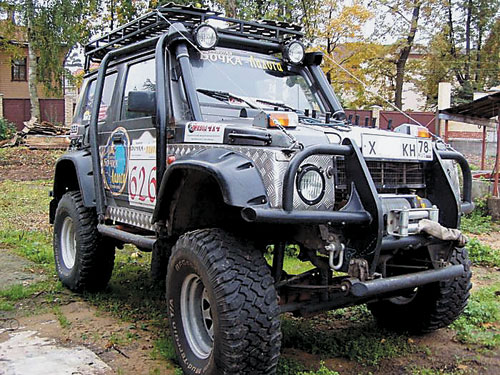
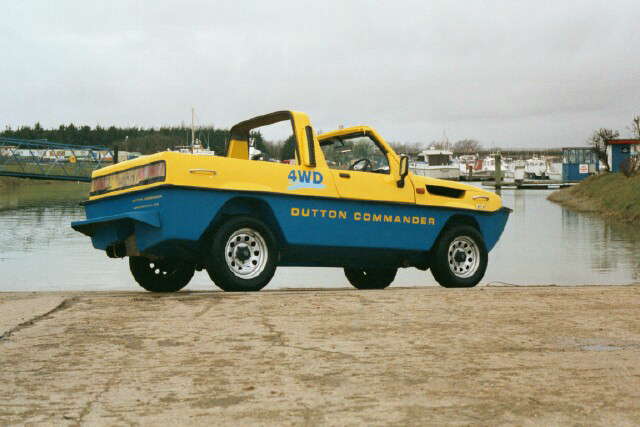
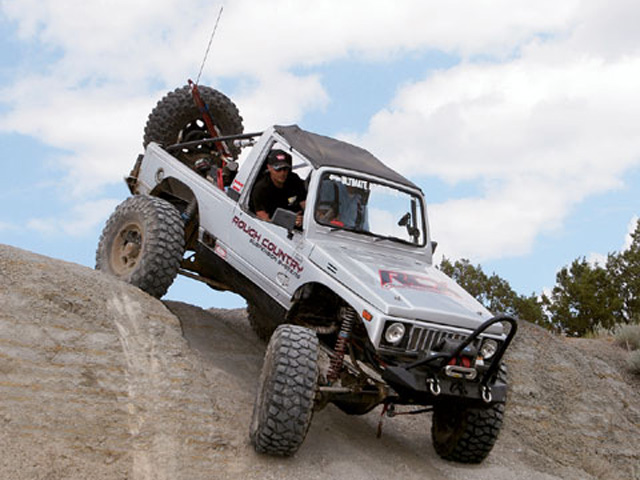
![0610_4wd_01z+suzuki_samurai+group_of_suzukis[1274].jpg](/images/gallery/favourites/0610_4wd_01z+suzuki_samurai+group_of_suzukis[1274].jpg)
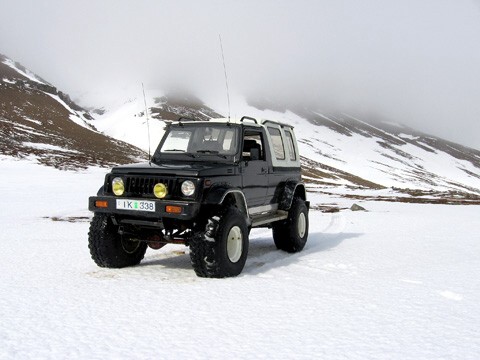
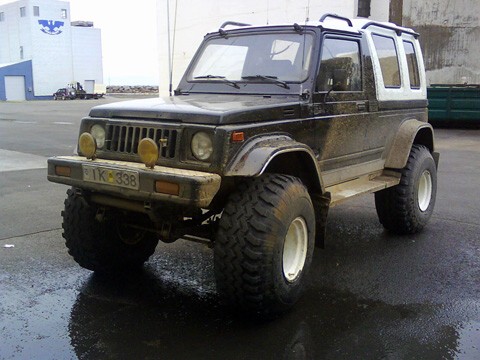

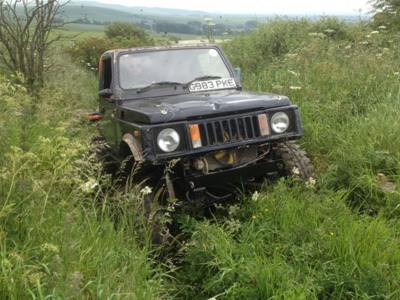
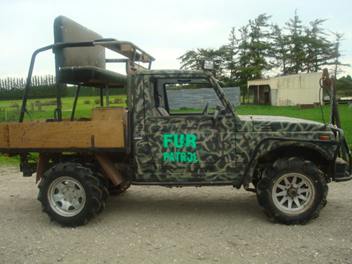

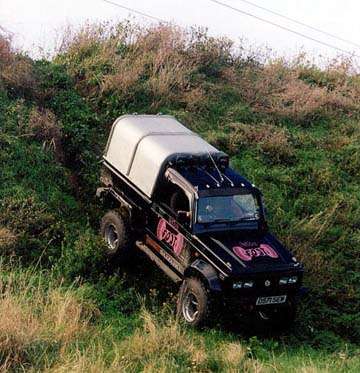
![fenderfrt6_SJ-1[376].jpg](/images/gallery/favourites/fenderfrt6_SJ-1[376].jpg)
